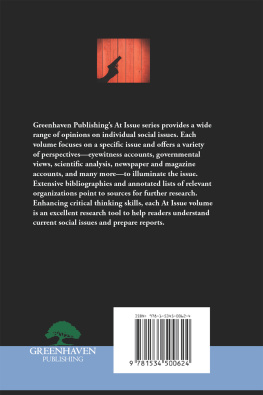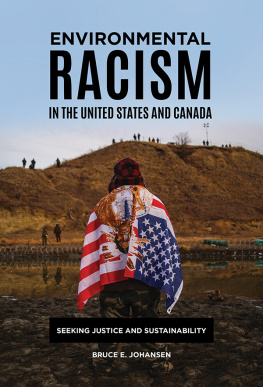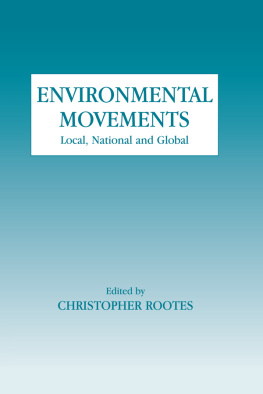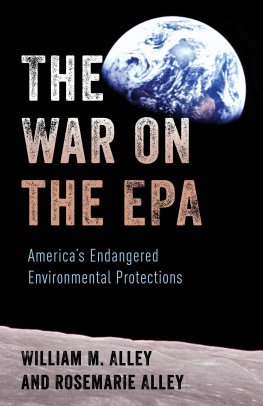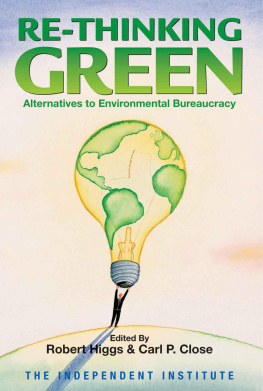Other Books in the At Issue Series:
Are Social Networking Sites Harmful?
Bilingual Education
Caffeine
Campus Sexual Violence
Can Diets Be Harmful?
Childhood Obesity
Corporate Corruption
Does the Internet Increase Anxiety?
Domestic Terrorism
Foodborne Outbreaks
Foreign Oil Dependence
Gender Politics
How Valuable Is a College Degree?
Immigration Reform
Invasive Species
The Olympics
Student Loans
Superbugs
Superfoods
Voter Fraud
What Is the Impact of Green Practices?
What Should We Eat?
Published in 2017 by Greenhaven Publishing, LLC
353 3rd Avenue, Suite 255, New York, NY 10010
Copyright 2017 by Greenhaven Publishing, LLC
First Edition
All rights reserved. No part of this book may be reproduced in any form without permission in writing from the publisher, except by a reviewer.
Articles in Greenhaven Publishing anthologies are often edited for length to meet page requirements. In addition, original titles of these works are changed to clearly present the main thesis and to explicitly indicate the authors opinion. Every effort is made to ensure that Greenhaven Publishing accurately reflects the original intent of the authors. Every effort has been made to trace the owners of the copyrighted material.
Cover image: Lightspring/Shutterstock.com
Library of Congress Cataloging-in-Publication Data
Names: Cunningham, Anne.
Title: Environmental racism and classism / Anne Cunningham.
Description: New York : Greenhaven Publishing, 2017. | Series: At issue | Includes index.
Identifiers: LCCN ISBN 9781534500402 (pbk.) | ISBN 9781534500167 (library bound)
Subjects: LCSH: Environmental policyUnited States. |
Racism United States. | ClassismUnited States.
Classification: LCC GE180.C75 2017 | DDC 363.70560973dc23
Manufactured in the United States of America
Website: http://greenhavenpublishing.com
Introduction
W hen we think of environmentalism, our first thoughts may go to issues of conservation such as how to save the Amazon rainforests or protect an endangered species of marine wildlife. However, a growing contingent of environmental activists are increasingly concerned with the many hazards and threats to a good quality of life and positive health in humanitys natural habitats the rural, suburban, and urban dwellings and communities where ordinary people live, work, and play. The broad movement for environmental justice seeks acknowledgment and redress of the unequal distribution of environmental hazards and risks according to social factors such as economic class, social status, and race.
Within the movement for environmental justice, a compelling subset of thinkers and activists hold that race is the paramount issue affecting environmental justice. Indeed, to some, the very term environmental justice is problematic in that it downplays the ways in which racism functions as the central cause of environmental injustice. Beginning with a study by the Congressional General Accounting Office (GAO) in 1983, the reality of environmental racism has gradually gained traction. Since then, many more research studies have cited strong evidence that the people who live closest to dangerous sources of pollution are overwhelmingly people of color. In other words, there is a greater chance that a so-called LULU (Locally Unwanted Land Use) would be sited for a middle-income African-American community than it would for an even much lower income but still majority white area. According to the GAO study, in eight southeastern states, only twenty-five percent of toxic waste landfill sites were located in primarily white neighborhoods. Subsequent reports such as the landmark Toxic Wastes and Race in the United States published by the United Church of Christs Commission for Racial Justice (CRJ) in 1987 provided much corroborating evidence underscoring the centrality of race for tough questions of environmental justice.
Robert Bullard, a leading opponent of environmental racism whose writing appears as a viewpoint in this resource, defines the issue of environmental racism as any environmental policy, practice, or directive that differentially affects or disadvantages (whether intended or unintended) individuals, groups, or communities based on race or color (Bullard 1993a). The key words above are intended or unintended. Thus, an institution or governmental body need not have explicitly nefarious whitesupremacist intentions to enact policy that is inherently racist. To begin with, minority groups usually have less political power, a problem exacerbated by board meetings that are often held at inconvenient locations or times, or conducted exclusively in English. These impediments to procedural equity can reduce a minority communitys participation in decision-making, and ultimately erode self-determination. Moreover, a racist history of land-use policies has sometimes codified discriminatory practice as zoning law. In the case of residents of the primarily African-American Eno Road neighborhood in rural Tennessee, zoning ordinance allowed a waste site to poison their drinking water, but left nearby rural white communities water unaffected. A recent court settlement for the many victims of illnesses caused by such blatant environmental racism is an important first step to rectify the abuse, and reiterate the existence of the problem.
Nonetheless, some authors from whom we will hear below claim that there is no such thing as environmental racism as such. Their viewpoints do not necessarily deny the reality of institutional racism, or environmental ills. Rather, their claim is that in a country where most of us have clean drinking water and basic health safeguards, environmental racism is a relatively minor issue, and simply an outgrowth of larger racial inequities in other systems such as education, employment, and housing, to take a few examples. Does the focus on environmental policy divert some governmental energy and resources away from these other issues? Undoubtedly. However, the denial of environmental racism outright may work as a rhetorical erasure, undermining how the struggle against environmental racism intersects with other anti-racist and classist projects.
Environmental racism is not just an American problem. European colonialism has long since exploited the resources of the Global South such as Africa, South America, and the Middle East, a process that continues today on a corporate level. The pursuit of profit is at the expense of local people, who find their living environments transformed into a wasteland of pollution and social chaos once all the valuable materials have been extracted. Moreover, the movement for climate justice points out that many nations that burn the least carbon are bearing the considerable costs of devastating weather events, sea level rise caused by dangerous levels of CO2 in the atmosphere caused by wealthier, heavily industrialized nations. International summits addressing climate change are taking these factors into account thanks to the efforts of this movement.
The viewpoints that follow each approach environmental injustice from overlapping angles. While their conclusions differ, taken together they demonstrate that much must still be done to ensure that all people have access to the basics of a healthy life, regardless of race, class, and geography.



